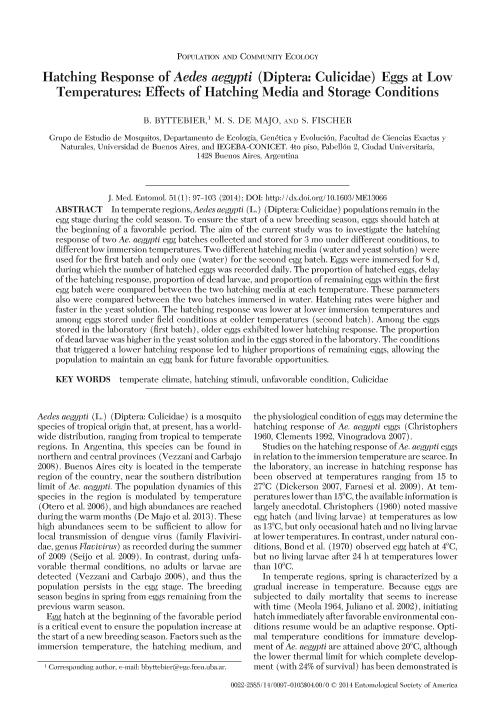Artículo
Hatching Response of Aedes aegypti (Diptera: Culicidae) Eggs at Low Temperatures: Effects of Hatching Media and Storage Conditions
Fecha de publicación:
12/2014
Editorial:
Entomological Society of America
Revista:
Journal of Medical Entomology
ISSN:
0022-2585
Idioma:
Inglés
Tipo de recurso:
Artículo publicado
Clasificación temática:
Resumen
In temperate regions, Aedes aegypti (L.) (Diptera: Culicidae) populations remain in the egg stage during the cold season. To ensure the start of a new breeding season, eggs should hatch at the beginning of a favorable period. The aim of the current study was to investigate the hatching response of two Ae. aegypti egg batches collected and stored for 3 mo under different conditions, to different low immersion temperatures. Two different hatching media (water and yeast solution) were used for the first batch and only one (water) for the second egg batch. Eggs were immersed for 8 d, during which the number of hatched eggs was recorded daily. The proportion of hatched eggs, delay of the hatching response, proportion of dead larvae, and proportion of remaining eggs within the first egg batch were compared between the two hatching media at each temperature. These parameters also were compared between the two batches immersed in water. Hatching rates were higher and faster in the yeast solution. The hatching response was lower at lower immersion temperatures and among eggs stored under field conditions at colder temperatures (second batch). Among the eggs stored in the laboratory (first batch), older eggs exhibited lower hatching response. The proportion of dead larvae was higher in the yeast solution and in the eggs stored in the laboratory. The conditions that triggered a lower hatching response led to higher proportions of remaining eggs, allowing the population to maintain an egg bank for future favorable opportunities.
Palabras clave:
Temperate Climate
,
Hatching Stimuli
,
Unfavorable Condition
,
Culicidae
Archivos asociados
Licencia
Identificadores
Colecciones
Articulos(IEGEBA)
Articulos de INSTITUTO DE ECOLOGIA, GENETICA Y EVOLUCION DE BS. AS
Articulos de INSTITUTO DE ECOLOGIA, GENETICA Y EVOLUCION DE BS. AS
Citación
Byttebier, Bárbara; de Majo, María Sol; Fischer, Sylvia Cristina; Hatching Response of Aedes aegypti (Diptera: Culicidae) Eggs at Low Temperatures: Effects of Hatching Media and Storage Conditions; Entomological Society of America; Journal of Medical Entomology; 51; 1; 12-2014; 97-103
Compartir
Altmétricas




